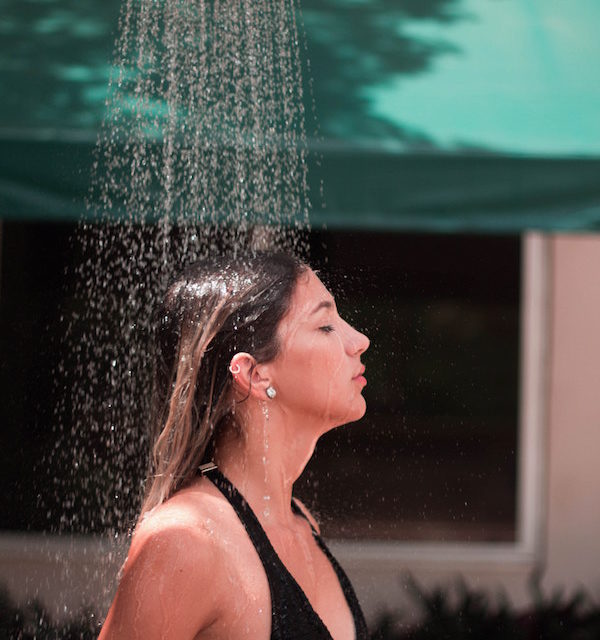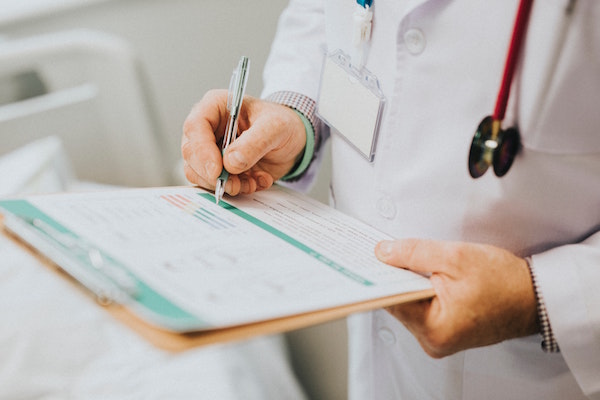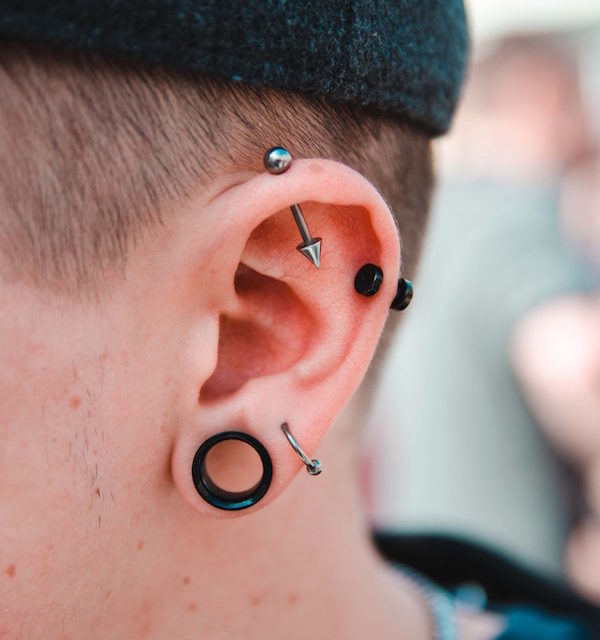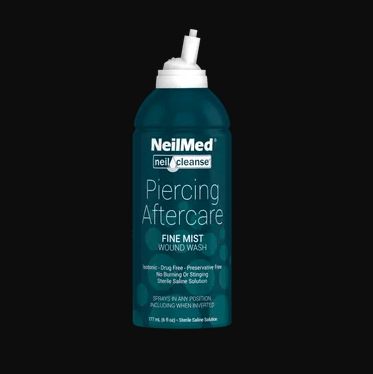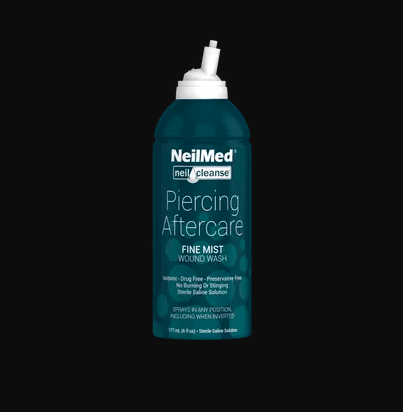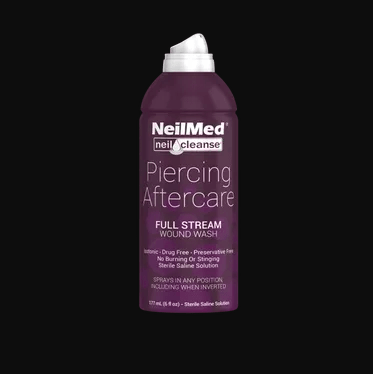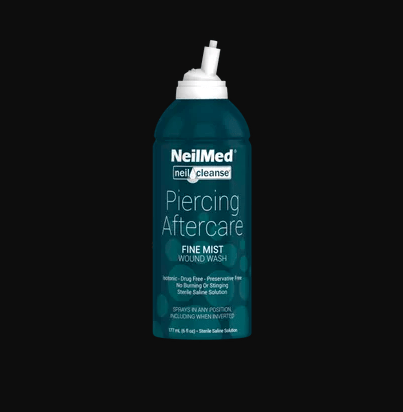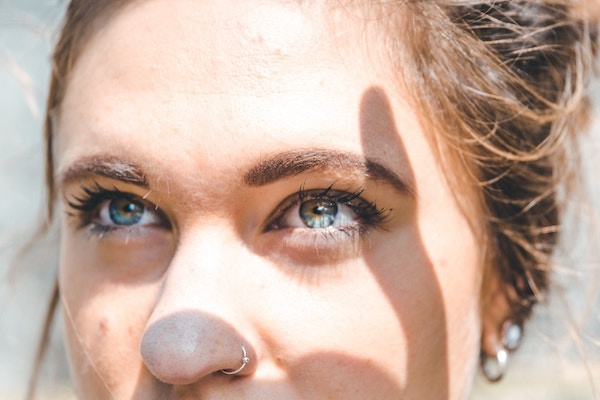Piercing Aftercare Practices: 6 Things to be Aware of As Your Piercing Heals April 18, 2019 – Posted in: Informative, Piercing Advice – Tags: aftercare practices, body jewelry aftercare, how to care for a new piercing, how to clean a new piercing, saline solution, saline solution for piercings
Piercing aftercare highlights:
- You must clean the front and back of your piercing 2 – 3 times daily with piercing aftercare saline solution.
- Keep your piercing dry and safe from friction, snags, and snares.
- Avoid activities that may harm the piercing, like swimming or wearing headphones.
You’ve done it! You researched your new piercing, gained the courage to sit in the piercer’s chair, and now you’re the proud owner of a new piercing. Now you need to think about piercing aftercare.
Although undergoing the piercer’s needle may seem like the most difficult part of the piercing process, your path to healing has only just begun. Depending on the piercing you chose, healing can take anywhere from 4 weeks to 12 months. During this time, you will need to make sure that you’re practicing proper aftercare to avoid complications that may prolong healing.
Beyond consistently cleaning the pierced area, you’ll need to make some lifestyle adjustments until your piercing has healed. Here are six things you need to do to keep your piercing safe and healthy throughout the healing period.
1. Keep the piercing clean
As your piercing heals, you need to make sure that you’re keeping it clean. Essentially, your body is healing from an open wound. As with any injury, you must keep the area clean to avoid infection.
Saline sprays are the best way to clean your piercing. To use, you just need to follow three simple steps:
- Wash your hands with soap.
- Spray the solution on a cotton swab or clean paper towel.
- Gently wipe the front and back of the piercing.
- Dab the piercing dry with a clean cotton swab or paper towel.
That’s it! It takes less time than brushing your teeth, and these simple steps will help you avoid infections, piercing bumps, and many other common piercing complications. You must continue to clean your piercing until your piercer has confirmed that healing is complete.
Shop for NeilMed Piercing Aftercare here.

Photo by Nichita Galactionov on Unsplash
2. Keep the pierced area dry
Dampness is one of a new piercing’s greatest foes. A damp piercing welcomes things like piercing bumps, infections, and other issues. In order to keep your piercing dry, you must refrain from activities like swimming or hot-tubbing, and make sure to dab your piercing dry with a clean paper towel or cotton swab right after you step out of the shower. Furthermore, if you find yourself sweating throughout the day, like after you exercise, you should dab the piercing dry or conduct a quick cleaning.
3. Try not to touch your new jewelry
As you adjust to your new jewelry, you might be tempted to play with it. Although the draw is understandable, you must fight against it; spinning or moving your jewelry can cause trauma to the pierced area.
In the first days of healing, your piercing will likely excrete some clear fluids, leading to some crusting around the piercing site. You’ll be tempted to pick it off, but this can lead to scabbing or permanent scarring. To clean off the crusties, you can dampen them with saline solution, then gently dab them away with a cotton swab or paper towel.
4. Make sure that your jewelry fits properly
In the days immediately after you’ve gotten pierced, you’ll experience some swelling. You need to make sure that your jewelry accommodates this.
Your piercer should help fit you with the right jewelry. However, it’s your responsibility to keep an eye on your jewelry during healing and make sure that the jewelry doesn’t press against the piercing. If it does, visit your piercer to get fit with a larger piece. Jewelry that presses against a piercing may cause some complications.
Conversely, you want to make sure that your jewelry isn’t too large. Long barbells in new lip piercings run the risk of being chomped upon, which can break your teeth. In other piercings, larger jewelry might fall out and can be more easily snagged. After your swelling has gone down, talk to your piercer about changing your jewelry to a smaller piece.
During healing, you always want to visit your piercer for any jewelry change. They know how to navigate the healing piercing without causing trauma to the skin. Even once you’ve completed the healing process, you should talk to your piercer before changing your jewelry. The inside of the piercing will take longer to heal than the outside, and your piercer will be able to investigate and let you know if your piercing is ready.

Photo by Terricks Noah on Unsplash
5. Know how to tell an infection from natural healing
Especially in the first days of healing, your piercing will experience swelling, throbbing, and some secretion of bodily fluids. While all of these symptoms are natural parts of the healing process, they can also be signs of more serious issues, so it’s important to understand when it’s natural healing and when you need to see a medical professional. Often, new piercees think that they are suffering from an infection when, in fact, the issue is much more minor.
It may be a piercing infection if:
- You went to bed with a healthy piercing, and extreme, painful symptoms appeared overnight.
- You see yellow or green excretion coming from the piercing. Clear or white discharge is fine.
- The piercing experiences inordinate swelling, especially if it’s weeks since you’ve been pierced.
- Your piercing feels warm to the touch.
A piercing infection is going to be uncomfortable, and symptoms will be intense. If symptoms have appeared gradually, and if they result in only slight discomfort, then it’s probably just normal healing. However, piercing infections are nothing to play around with, so if you have any doubt, it’s best to seek a professional opinion immediately.
6. Keep your piercing safe from harmful products
The only cleaning product you should be using is piercing aftercare saline solution. Keep makeup, lotion, sunscreen, and other products away from your piercing. These contain ingredients that could be irritating, potentially prolonging healing or causing other complications.
You also need to be careful about the clothing you wear around your piercing. Keep scarves, hats, and other clothing items away from your piercing. These pose a snag risk and place pressure on the piercing, which can cause a host of issues.
Piercing aftercare can be a bit of a process, but when your aftercare practice has ended and you’re left with a gorgeous new piercing, it will be worth it. Always err on the side of caution, and adhere to all aftercare practices until a piercer has confirmed that healing is complete.





